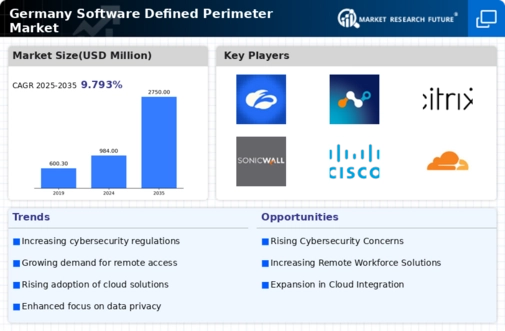Shift Towards Remote Work
The transition to remote work has significantly influenced the software defined-perimeter market in Germany. As organizations adapt to flexible work arrangements, the need for secure remote access to corporate resources has become paramount. In 2025, approximately 30% of the German workforce is expected to work remotely at least part-time, necessitating robust security solutions. Software defined-perimeter technologies offer a means to ensure secure connections for remote employees, thereby protecting sensitive information from unauthorized access. This shift is likely to drive market growth, as companies seek to implement solutions that facilitate secure collaboration and communication among distributed teams.
Rising Cybersecurity Threats
The software defined-perimeter market in Germany is experiencing growth due to the increasing frequency and sophistication of cyber threats. Organizations are compelled to adopt advanced security measures to protect sensitive data and maintain operational integrity. In 2025, it is estimated that cybercrime could cost businesses globally over $10 trillion annually, prompting German enterprises to invest in software defined-perimeter solutions. This market is projected to grow at a CAGR of 20% from 2025 to 2030, driven by the urgent need for enhanced security frameworks. As companies face potential breaches, the demand for software defined-perimeter technologies that provide secure access to applications and data is likely to rise, making it a critical component of modern cybersecurity strategies.
Increased Regulatory Pressures
The software defined-perimeter market in Germany is also shaped by stringent regulatory requirements surrounding data protection and privacy. The General Data Protection Regulation (GDPR) mandates that organizations implement adequate security measures to safeguard personal data. As compliance becomes increasingly critical, businesses are turning to software defined-perimeter solutions to ensure they meet regulatory standards. In 2025, it is anticipated that non-compliance could result in fines amounting to €20 million or 4% of annual global turnover, whichever is higher. This financial risk drives organizations to invest in technologies that enhance their security posture and facilitate compliance with evolving regulations.
Growing Demand for Cloud Services
The software defined-perimeter market in Germany is benefiting from the rising adoption of cloud services. As more organizations migrate their operations to the cloud, the need for secure access to cloud-based applications becomes essential. In 2025, the cloud services market in Germany is projected to reach €30 billion, with a significant portion of this growth attributed to the demand for secure access solutions. Software defined-perimeter technologies provide a framework for secure connections to cloud environments, ensuring that data remains protected during transmission. This trend is likely to drive further investment in software defined-perimeter solutions as organizations seek to leverage the benefits of cloud computing while maintaining robust security measures.
Technological Advancements in Security Solutions
The software defined-perimeter market in Germany is poised for growth due to ongoing technological advancements in security solutions. Innovations such as artificial intelligence and machine learning are enhancing the capabilities of software defined-perimeter technologies, enabling organizations to detect and respond to threats more effectively. In 2025, it is expected that the integration of AI-driven security solutions will account for over 25% of the software defined-perimeter market. These advancements not only improve threat detection but also streamline security management processes, making it easier for organizations to implement and maintain robust security frameworks. As technology continues to evolve, the demand for sophisticated software defined-perimeter solutions is likely to increase.
























Leave a Comment